 At Microsoft, we believe our employees are the company’s greatest asset. That’s why, in 2017, we determined that for Microsoft to achieve its mission of empowering every person and every organization on the planet to achieve more, we would need to transform the way we do IT.
At Microsoft, we believe our employees are the company’s greatest asset. That’s why, in 2017, we determined that for Microsoft to achieve its mission of empowering every person and every organization on the planet to achieve more, we would need to transform the way we do IT.
Why change?
We realized that to help our customers transform through technology, we needed to transform the experience for our own employees. The investments we made in a reimagined employee experience enabled Microsoft employees to innovate, create, and collaborate seamlessly.
Our shift to the Microsoft Azure cloud made us more agile. But even with a forward-looking vision and people-centric investments, nothing could have prepared us for March of 2020, when Microsoft employees globally were sent home to protect their health and safety. The era of hybrid work had begun.
In this article, we share how we’re making hybrid work, work at Microsoft. Our goal is to help fellow digital transformation leaders learn from our experience keeping over 300,000 people productive, connected, and empowered around the world. It describes our journey from Microsoft IT to Microsoft Digital; how we’re helping Microsoft and our customers thrive in the hybrid workplace across digital experiences, physical spaces, and cultural norms; our investments in AI to revolutionize our IT infrastructure, employee experiences, and corporate functions portfolio; and building and driving adoption of transformative new technologies like Microsoft 365 Copilot, Microsoft Viva, Microsoft Teams, and the Microsoft Power Platform.
Becoming Microsoft Digital
For years, Microsoft IT operated like a traditional IT organization—highly reactive to circumstances and more focused on the technology than the experience. Of course, we cared about the experience of our users, but it was mostly outside of our direct control, as we primarily deployed and sustained solutions built by other teams or other companies. In 2017, we adopted a new name—End User Services Engineering—which reflected our transition to a modern engineering organization. Our team was now “vision-led,” focused on building and deploying the right solutions to meet the needs of people, not just deploying the latest technology. We became proactive visionaries rather than reactive practitioners.
That transformation culminated with our transition to becoming Microsoft Digital. At the core of that transformation is an obsession with the needs of our employees that transcends tools and infrastructure and extends to the entirety of their daily experience, from the day they’re hired to their eventual retirement. We steward their digital experience through every dimension of their employment, ensuring they have the devices, applications, services, and infrastructure needed to be productive on the job no matter where they are or what they do.
While our journey to deliver a world-class digital experience for Microsoft employees began years ago, the COVID-19 pandemic unexpectedly enabled us to accelerate the evolution of our employee experience. Grappling with the pandemic gave us time and insights necessary to ensure that everyone at Microsoft has a great digital experience, whether they’re in the office or working remotely.
Subsequent sections of this article demonstrate how we’re bringing that vision to life for Microsoft’s global employees so they can thrive in a hybrid world.
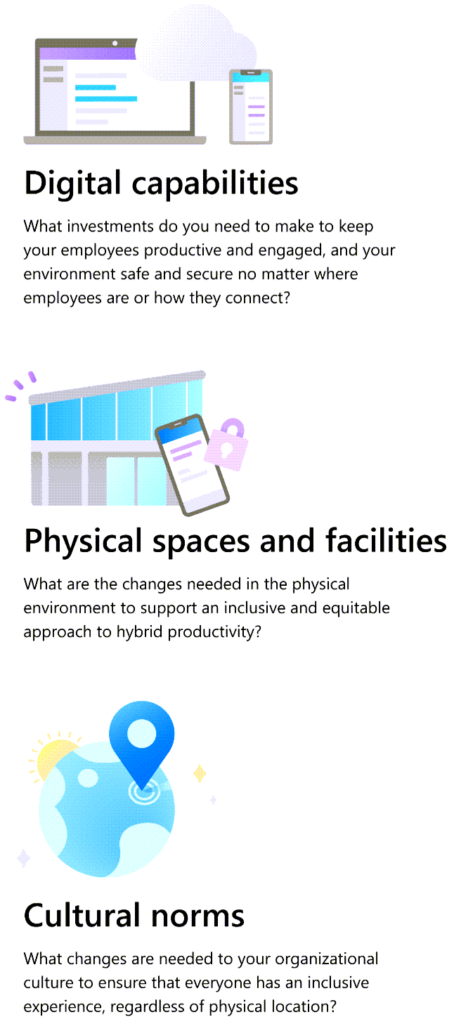
Thriving in a hybrid world
Like most large companies, our shift to remote work happened almost overnight, with impacts to company culture, infrastructure, and processes that have lasted well beyond the end of the Covid-19 pandemic. The implications of hybrid work continue to resonate—from this moment forward, every investment needs to be considered through multiple dimensions of the employee experience: digital capabilities, physical spaces, and culture.
The sections that follow reflect on our journey at Microsoft across these three dimensions of the employee experience.
Digital capabilities
The pandemic and subsequent shift to hybrid work served as an accelerant to our efforts to revolutionize the employee experience for our employees and customers, with Microsoft Viva the centerpiece of that effort. In 2023, breakthroughs in generative AI enabled entirely new ways to support employee productivity, enabling Microsoft Digital to rethink “core” IT and to reimagine employee productivity with Microsoft 365 Copilot.
Additionally, other transformative investments in Microsoft Teams, the Microsoft Power Platform, and many other technologies are helping us accelerate the transformation of our employee experience, while a Zero Trust security posture keeps our enterprise safe and secure and our employees productive. More on each of these investments follows.
Microsoft Viva
When millions of people globally left the office to work from home in 2020, it marked a tectonic shift in how employees experienced the workplace and how companies supported their own employees to keep them safe and productive during a pandemic. Among the millions were thousands of Microsoft employees, and our challenges are like yours—how do we stay connected, informed, and motivated as we transition to the new world of hybrid work?
Despite positive feedback from many employees about the new availability of flexible work options, our CEO Satya Nadella describes a hybrid paradox wherein employees want both more flexible work options as well as additional opportunities to connect and collaborate with colleagues in person. And there is also compelling evidence that as employees have fewer opportunities to expand their networks and make new connections, innovation suffers. This is where Microsoft Viva initially came to market as a single, coherent platform built around the employee. Ultimately, the initial goals were centered around employee connection, wellbeing, and productivity. Now, since Viva’s 2021 launch, that experience has since shifted, rapidly evolving to a present-day focus on business impact and performance, driven by global macroeconomic concerns.
Microsoft Viva has also introduced several new Viva apps since initial launch, and the Microsoft Viva deployment at Customer Zero now includes extra capabilities in support of the new focus:
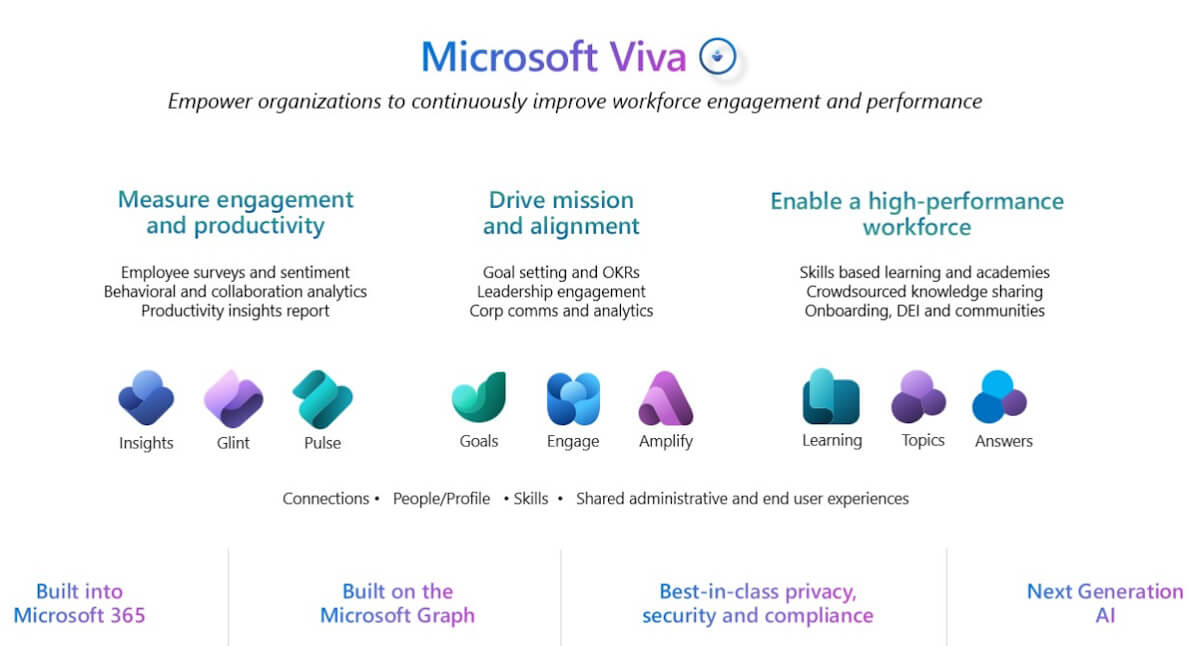
At Customer Zero, we are looking forward to new incoming AI-enabled features across the Viva Suite and seeing how these capabilities improve the employee experience. In the interim, we are still capturing employee feedback and sentiment to continue to improve the capabilities across Viva for our employees and customers, and we’re excited for what the future holds for the platform.
Transforming with AI
Employee productivity reached a new level in 2023 with the widespread use of AI. Microsoft 365’s generative AI has unlocked amazing new features that assist employees with essential tasks like composing emails, making presentations, summarizing meetings, searching for information, and more. The AI era has arrived!
AI offers new possibilities to improve employee experiences like never before, enabling seamless collaboration, personalized workflows, and simplified engagement across the organization. AI will simplify the many systems our employees must use and access, reducing daily work challenges, providing flexibility to perform tasks at any time and place, and enabling smooth cooperation in a hybrid work environment.
“The potential for transformation through AI is nearly limitless. We’re evaluating every service in our portfolio to consider how AI can improve outcomes, lower costs, and create a sustained competitive advantage for Microsoft and for our customers,” says Nathalie D’Hers, CVP, Microsoft Digital.
In addition to those typical employee productivity situations, we see that AI can transform other IT services and spark a wave of innovation that can enhance outcomes, reduce costs, and boost productivity for employees everywhere. We are taking advantage of this moment to use the power of AI to simplify operations and enhance services across our vast portfolio. Our goal is to use our extensive expertise of enterprise IT to speed up Microsoft’s own AI transformation while helping our customers to leverage this generational opportunity to speed up their own digital transformation.
One technology that will be central to our transformation is Microsoft 365 Copilot. Copilot helps you create and edit documents, presentations, emails, and more with the power of AI. It can suggest content, formatting, design, and data based on your context and preferences. It can also help you collaborate with your team and access relevant information from various sources. Research shared by Microsoft’s WorkLab team showed that early adopters of Copilot have seen remarkable benefits to their productivity:
- 70% of Copilot users said they were more productive.
- 68% said it improved the quality of their work.
- Users were 29% faster in a series of tasks (searching, writing, and summarizing).
- 77% of users said once they had Copilot, they didn’t want to give it up.
Another key technology that will transform the employee experience at Microsoft is Microsoft 365 Chat. Microsoft 365 Chat will act as a core engagement hub for our employees, enabling Microsoft Digital to redesign the employee experience to no longer be app centric, but rather employee centric. Microsoft 365 Chat will enable employees to access essential information in a summary fashion rather than as a multitude of search results, delivered through highly context aware and natural language Q&A while also performing tasks seamlessly.
We’re in the early days of designing these AI-powered employee experiences and will share more as our vision matures.
- Microsoft 365 Chat
- What Can Copilot’s Earliest Users Teach Us About Generative AI at Work?
- Microsoft 365 Copilot adoption
Hybrid meetings with Microsoft Teams
Our deployment, maintenance, and support of thousands of conference rooms around the globe is a significant challenge. Because employees often encounter different conference room technology—even within the same building—it can lead to frustration, delay, and even support calls. As we prepare for a return to the workplace, we’re preparing our physical and virtual capabilities for an improved hybrid meeting experience.
An unexpected result of remote work has been an increase in meeting experience satisfaction by 31 points. The primary reason for that increase in satisfaction is simple—universal remote meeting participation helps create an even playing field, with a more inclusive atmosphere for all. Remote participants are no longer at a disadvantage to their peers attending in person, and as a result feel more included in discussion and meeting outcomes. A key priority as we prepare for the hybrid work environment will be to retain that inclusive environment and employee satisfaction through a combination of changes to physical spaces, improvements in our digital capabilities, and establishment of cultural norms that codify beneficial behaviors that began during the pandemic.
One way we’re extending that momentum is by taking full advantage of the new features in Microsoft Teams as well as new hardware in meeting rooms, like intelligent AI-powered cameras that help everyone participate equally in meetings. We will continue to take advantage of Microsoft Teams features that drive interaction and participation like meeting chat, the “raise hand” feature, as well as reactions, emojis, and integrated GIF support ensure a productive and interactive meeting experience for all.
Microsoft Teams benefits from Copilot integration as well, enabling users to quickly recap, identify follow-up tasks, create agendas, or ask questions for more effective and focused meetings. Intelligent Recap in Teams Premium can summarize key takeaways, help employees see what they’ve missed, and even pinpoint key people of interest in chats.
We’re continuing to retrofit conference rooms to utilize the latest Microsoft Teams Rooms features and capabilities, and we’ll keep partnering with the Microsoft Teams product group to push the envelope with innovative new capabilities that take advantage of investments in hardware, software, and physical space to create immersive and inclusive environments. We’ll achieve that while being sensitive to cost, prioritizing employee value. Like our customers, we face budget constraints, but we invest when we’re convinced that we’re delivering sufficient value to our employees to justify the expense. Our goal is to improve our current meeting rooms at a global scale while selectively deploying high-end rooms in targeted locations based on need. In that way, we’ll modernize the experience for all our employees while also delivering maximum value to Microsoft.
- Buzzing on Microsoft Teams Rooms technology at the Hive
- Get started with Copilot in Microsoft Teams meetings
- Advancing your meetings with the Microsoft Teams Meeting guide
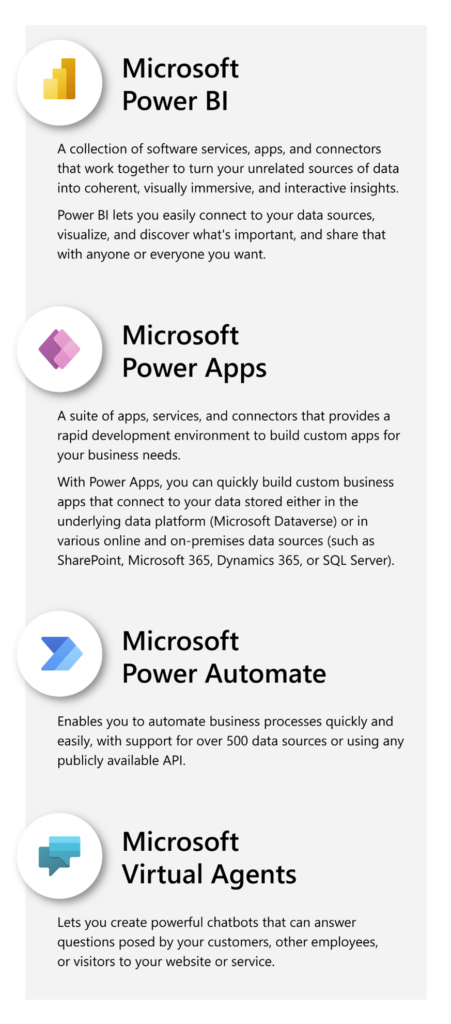 Microsoft Power Platform
Microsoft Power Platform
While we have thousands of highly skilled developers and engineers at Microsoft, we also have thousands of employees who are not engineers by trade, but who contribute to our success as citizen developers using the Microsoft Power Platform.
Citizen developers use no-code/low-code solutions to accelerate digital transformation of their workstreams. At Microsoft, the technologies that comprise the Microsoft Power Platform empower literally anyone in the company to transform our employee experience. After all, who’s the person most likely to identify a process that could benefit from automation, or most likely to need to collect, visualize, and analyze data? It’s not normally someone in a central IT team—it’s the employee who is closest to the problem or opportunity.
The Microsoft Power Platform—as shown in this companion graphic—is comprised of four distinct capabilities that have made Microsoft more agile and productive than ever before.
Each tool is easy to learn and allows your team to enable digital transformation from the front lines of your workforce, empowering your employees and fueling innovation.
- Microsoft Azure sellers gain a data edge with the Microsoft Power Platform
- Powering decision making at Microsoft by analyzing data with Microsoft Power BI
- Rethinking supplier content at Microsoft with Microsoft Power Automate
Securing employee experiences across devices, apps, and infrastructure
When the COVID-19 pandemic disrupted the global economy in 2020, Microsoft was more prepared than most organizations, not because we had anticipated the pandemic, but because we had already done the work to shift nearly every critical workload to the cloud, implementing a Zero Trust security model. A cloud-first strategy is critical in a hybrid world.
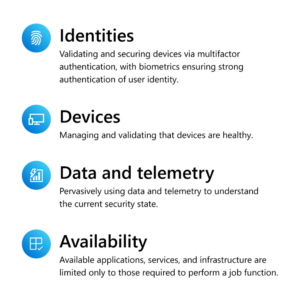 Zero Trust security ensures a healthy and protected environment by using the internet as the default network with strong identity, device health enforcement, and least privilege access. It reduces risk by establishing strong identity verification, validating device compliance prior to granting access, and ensuring least privilege access (just-in-time, just-enough-access) to only explicitly authorized resources.
Zero Trust security ensures a healthy and protected environment by using the internet as the default network with strong identity, device health enforcement, and least privilege access. It reduces risk by establishing strong identity verification, validating device compliance prior to granting access, and ensuring least privilege access (just-in-time, just-enough-access) to only explicitly authorized resources.
Zero Trust requires that every transaction between systems is validated and proven trustworthy before the transaction can occur. Ideally, the behaviors shown in this companion graphic are required.
The security threat landscape continues to change, with attacks on corporate networks increasing in frequency and complexity, partially as a byproduct of hybrid work. Through our Zero Trust security posture, Microsoft Digital plays a significant role in protecting our corporate assets and securing the enterprise while ensuring our employees have the best possible day-to-day experience. By implementing Zero Trust within your organization, you too can mitigate threats to your critical enterprise infrastructure.
- Implementing a Zero Trust security model at Microsoft
- Transitioning to modern access architecture with Zero Trust
- Zero Trust Model – Modern Security Architecture | Microsoft Security
Physical spaces and facilities
One of the three critical questions that all digital transformation leaders need to ask as they consider a return to the workplace is “What are the changes needed in the physical environment to support an inclusive and equitable approach to hybrid productivity?” After all, the best digital experiences mean very little if you don’t have the right physical spaces or hardware to maximize their potential for collaboration. And even more important than productivity is “How can I keep my employees safe and healthy?”
Between our Microsoft Global Workplace Services (GWS) team and Microsoft Digital, we represent the “front door of Microsoft”— the technology and the facilities. The first impression employees and visitors have when they walk into Microsoft is the physical environment and the technology they interact with, and we want their experience to be amazing. As Microsoft Digital’s Becky West put it in her recent article:
Typically, technology is added to a building many years or even decades after building construction. For example, software for booking a conference room or reserving a campus shuttle is developed independently from an office building being built, bought, or leased. This model works OK. However, to truly transform, technology needs to be integrated into the building, which requires a tight real estate and IT partnership.
While Commercial Real Estate (CRE) leaders and digital transformation leaders see things through different lenses, when both functions are aligned on vision with shared priorities and implementation, accelerated transformation of the employee experience is possible. The following are some examples of the work we’ve done with our counterparts in GWS to enable new experiences:
- The lobby check-in experience is literally the first impression an employee or visitor has when they visit a Microsoft facility, and in a hybrid work environment it’s even more important to streamline and automate that experience. Working together, we built an amazing new guest management system, with streamlined check-in and optimized check-out procedures to help employees or visitors quickly get to their next destination.
- Through our Microsoft employee mobile app, we’re enabling several new capabilities in conjunction with GWS, including the ability to order ahead at Microsoft cafeterias, or book a conference room or workspace. Soon our employees will have the ability to find available parking near their assigned workspace or meeting facility.
- With Microsoft Azure Digital Twins and IoT connected devices, we’re powering smart buildings at Microsoft. By integrating inputs from previously siloed data sources (like motion and occupancy sensors), we’re evolving the way Microsoft employees interact with their spaces, with a focus on efficiency and productivity.
- With Microsoft Dynamics 365 running on Microsoft Azure, we’re working together to consolidate all facility management processes and provide them to our vendors.
- Working together, we built a simple-to-use health attestation app using the Microsoft Power Platform to ensure that our employees acknowledge their health and vaccination status before entering a Microsoft facility. Microsoft even released a version that’s free for eligible customers.
None of these capabilities would have been possible without a strong partnership with our real estate colleagues in GWS, supported by a shared vision of the employee experience. We’ve learned that working together on a shared vision informed by employee and industry data, carefully researched by user experience designers, and using our full portfolio of digital experiences leads to transformative outcomes.
By reimagining the physical and virtual spaces at Microsoft, we’re laying a foundation of innovation that will help our employees thrive in the hybrid workplace.
- Creating the digital workplace at Microsoft
- Accelerating Microsoft’s global real estate transformation with Microsoft Digital
- Using Azure Digital Twins and IoT to modernize Microsoft buildings
- Transforming how Microsoft manages its corporate real estate data
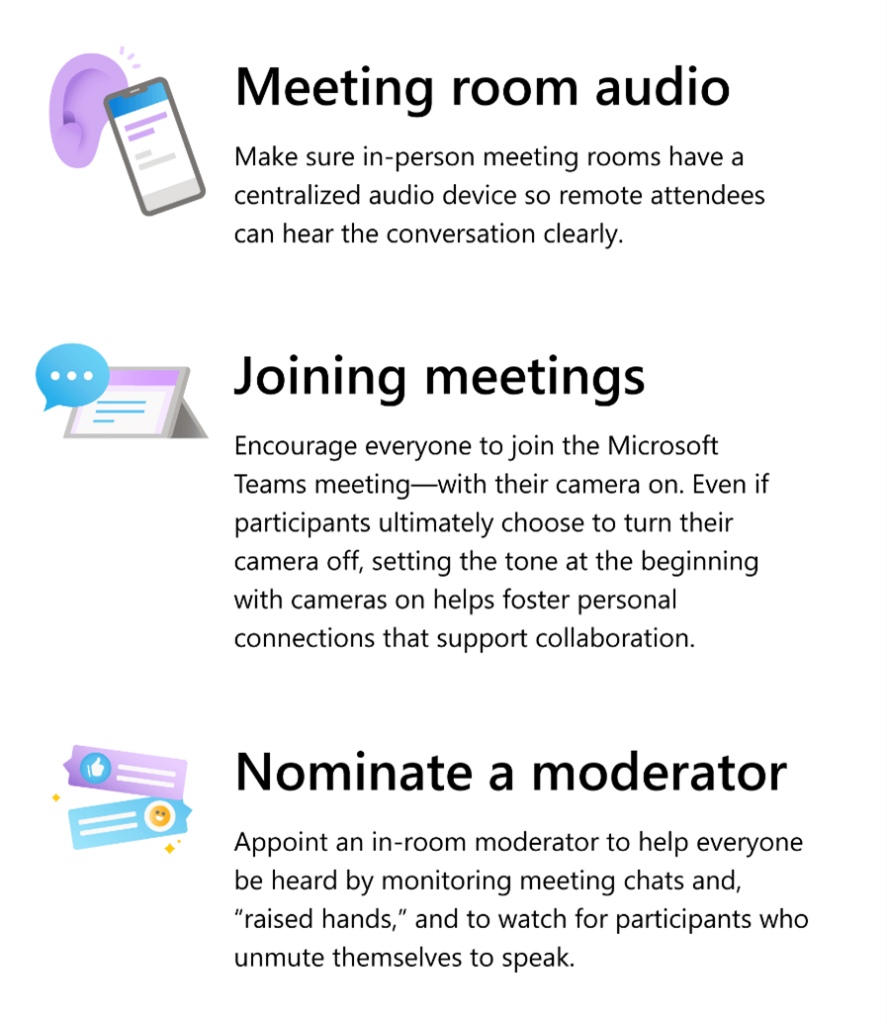 Cultural norms
Cultural norms
While investments in hardware and physical spaces are important, the greatest technology in the world won’t help unless people embrace best practices and apply consistent norms to ensure that all meetings are inclusive and that remote participants continue to have a great experience. While norms might vary based on your location, culture, and technical capabilities, digital transformation leaders should consider simple steps like those shown in this graphic.
These are just a few of the behaviors and standards to consider codifying as norms in your organization to support productive and effective hybrid meetings. For additional tips, please review this Tips for staying productive in an evolving hybrid world article. The following resources offer additional guidance, insights, and ideas for maximizing the productivity and effectiveness of hybrid meetings.
- How Microsoft is reimagining meetings for a hybrid work world
- Driving Inclusive and Effective Meetings at Microsoft with Microsoft Teams
- Designing the New Hybrid Meeting Experience—for Everyone
- WorkLab Live: Andrew Wilson and Nathalie D’Hers on the future of hybrid work
- To Thrive in Hybrid Work, Build a Culture of Trust and Flexibility
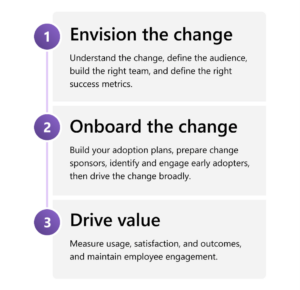
Driving adoption of new employee experiences
An often-overlooked aspect of digital transformation is the need for consistent and principled change management services to ensure your employees realize the value of the investments you make in their experience. In fact, the importance of change management is so great, it’s reflected in our organizational vision.
Microsoft Digital is fortunate to have a global team of change management practitioners to help ensure that our employees benefit from the value of our innovations. We’ve also benefited from the Microsoft 365 standardized approach to change management. This simple three-stage model can help teams of all shapes and sizes unlock the value of their investments in digital transformation.
In addition to practical guidance, case studies, and templates, Microsoft also makes available free courseware to develop your skills as a service adoption specialist. This is a great way to develop the skills your team will need to unlock the value of digital transformation in the hybrid workplace.
- Microsoft 365 Adoption – Get Started
- How Microsoft used change management best practices to launch a new business intelligence platform
- Driving the transformation of Microsoft’s employee experience with investment prioritization
Conclusion
The world of work has changed dramatically in the last few years. The first big shock was hybrid work, and the next is generative AI. We’ve captured some of our key learnings from that journey in this article and hope they will inspire you as you consider your own pathway to the future of work.
Hybrid work is more than a change in technology—it’s a change in mindset, a change in culture, and a change in the way you think about physical and virtual spaces to enable an inclusive and productive environment for all. The change isn’t easy, but it’s worth it. If you make the time to do it right, your employees will be more engaged, more productive, and more connected, even when they’re miles away. And they’ll be far less likely to leave for a competitor who has a more sophisticated and flexible model than you do.
Generative AI, like Microsoft 365 Copilot, has the potential to unlock creativity, productivity, and effectiveness in your workforce. Be bold in embracing AI in the workplace, so your employees have the tools they need to stay ahead of your competition.
The future of work will continue to evolve, and we’ll all learn along the way. As we continue our journey, we’ll keep you updated on our progress and learnings.
- Rethink your employee experience across your digital capabilities and physical spaces to meet your business needs in a hybrid world.
- Focusing on the three critical elements of the employee experience—digital capabilities, physical space and facilities, and organization culture—will help your organization to thrive in the hybrid workplace of the future.
- Microsoft Viva can help your employees find balance in the hybrid work environment, enabling you to retain talent in a competitive labor market.
- Microsoft 365 Copilot can unlock creativity and productivity in your workplace, while giving your organization an edge as AI becomes a key tool for organizational effectiveness.
- Use the Microsoft Power Platform to unlock innovation from your front lines by enabling your citizen developers to visualize and analyze data, build apps that address common business scenarios, and automate business processes.
- Adopting a Zero Trust security posture will keep your network secure and your employees safe.
- Build a strong partnership between your IT and real estate teams.
- Ensuring you have effective change management policies in place will help you extract value from your investments in digital transformation.
- Learn about Microsoft 365 Copilot.
- Check out these hybrid work solutions for your hybrid workplace.
- Read this WorkLab story on vital facts about the future of work.
- Find out if we’re ready for the disruption that hybrid work is creating for us.
Want more information? Email us and include a link to this story and we’ll get back to you.








